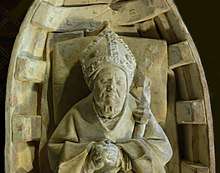Aredius
Saint Aredius (c. 510–591), also known as Yrieix, was Abbot of Limoges and chancellor to Theudebert II, King of Austrasia in the 6th century. He founded the monastery of Attanum, and the various French communes called St. Yrieix are named after him.
Aredius | |
|---|---|
 Saint Aredius | |
| Abbot | |
| Born | c. 510 Limoges, France |
| Died | 591 |
| Venerated in | Roman Catholic Church |
| Canonized | pre-congregation |
| Feast | 25 August |
Background
Aredius was from a prominent Gallo-Roman family of Limoges. He was the son of a noble landowner, Jucundus, and his wife, Pelagia of Limoges. As a young boy he received his education from the abbot Sebastian of the monastery at Vigeois. As a young man, he was sent to the court of the Frankish king Theodebert I of Austrasia (534-48) at Trier. By 540 was appointed chancellor.[1]
Nicetius bishop of Trier persuaded Aredius to leave the dissolute life at court. According to Gregory of Tours, one day, while the clerics sang psalms in the church, a dazzling white dove, after flying around Aredius, landed on his head, as if to show that he was already filled with the Holy Spirit. As he was a little shy, he waved it away, and it flittered a little before landing on its shoulder, and followed him all the way to the bishop's house.[2]
Upon the death of his father, Aredius returned to the Limousin to care for his mother. Entrusting to her the management of his estates, he lived for a time as a hermit in a cave. He used his inheritance to found in the 564/572 monastery of Atane (Attane) on land from his villa Attanum on the rivers Loue and Couchou in Limousin (Haute-Vienne). He became an abbot in the monastery, and the first monks were members of his own household. Gregory of Tours says that the house followed the rule of Cassian and later incorporated some aspects of the rule of St. Basil. Later, other monks joined them. This later became the site of the city of Saint Yrieix.[3]
Aredius divided his time between agricultural labor and study. He was known for his evangelical journeys throughout Gaul. He founded monasteries in Vigeois and Excideuil in Périgord and went on pilgrimages, always on foot. Every year he made a pilgrimage to Tours to celebrate the feast of St. Martin. He would also travel annually to the Holy Cross Abbey in Poitiers to visit Queen Radegund. He supported the cult of Saint Medard of Soissons and probably built the church in his honor at Excideuil. Aredius built several churches in honor of saints whose relics he had collected.[3]
Miracle stories began to be associated with him. People in the area believed him to have the gift of healing. Gregory says they crowded to Aredius "like bees to a hive".[4] On more than one occasion, he intervened with the Merovingian princes on behalf of the people regarding oppressive taxes.
He was a friend of Gregory of Tours, and bequeathed some of his wealth to the church at Tours.[5]
The town of Saint-Yrieix-La-Perche has requested that the Metropolitan Museum of art in New York return a reliquary of St. Aredius, which the town maintains was illegally purchased in 1906.[6]
References
- Goyau, Georges (1910). "Limoges". The Catholic Encyclopedia. New York: Robert Appleton Company.

- Montalembert Charles Forbes René de (1912). The Monks of the West. P.J. Kenedy. p. 477.
- Per Einar. "Den hellige Aredius av Limoges (d. 591)", Den katolske kirke".
- Charles Forbes René de (1896). "Monks of the West". Longmans, Green. p. 161.

- Fletcher, Richard A. (1999). The Barbarian Conversion: From Paganism to Christianity. University of California Press. p. 61. ISBN 9780520218598.
- Rea, Naomi (2018-01-16). "Tiny French Town Demands the Restitution of a Religious Reliquary From the Met". ArtNet News.